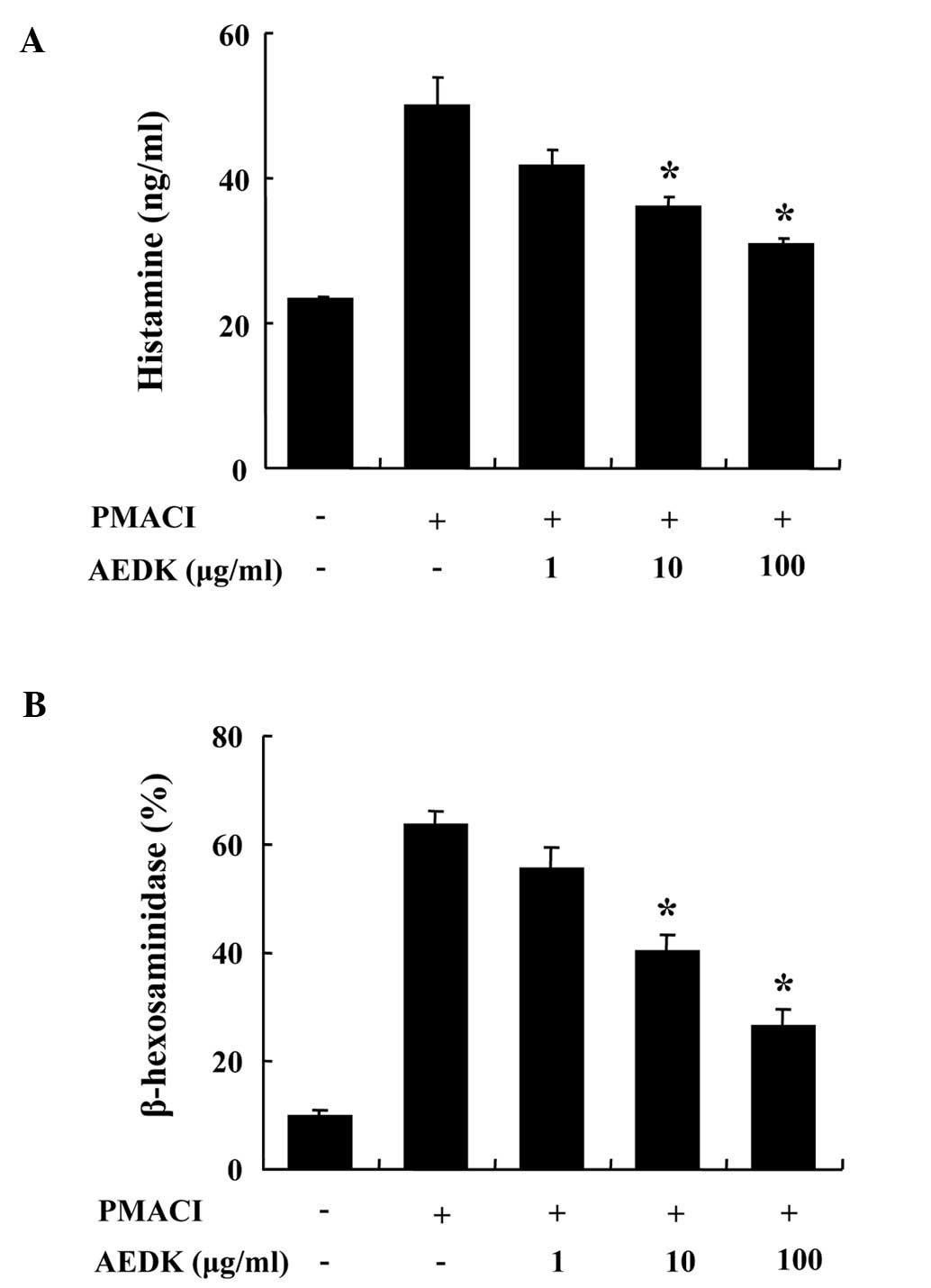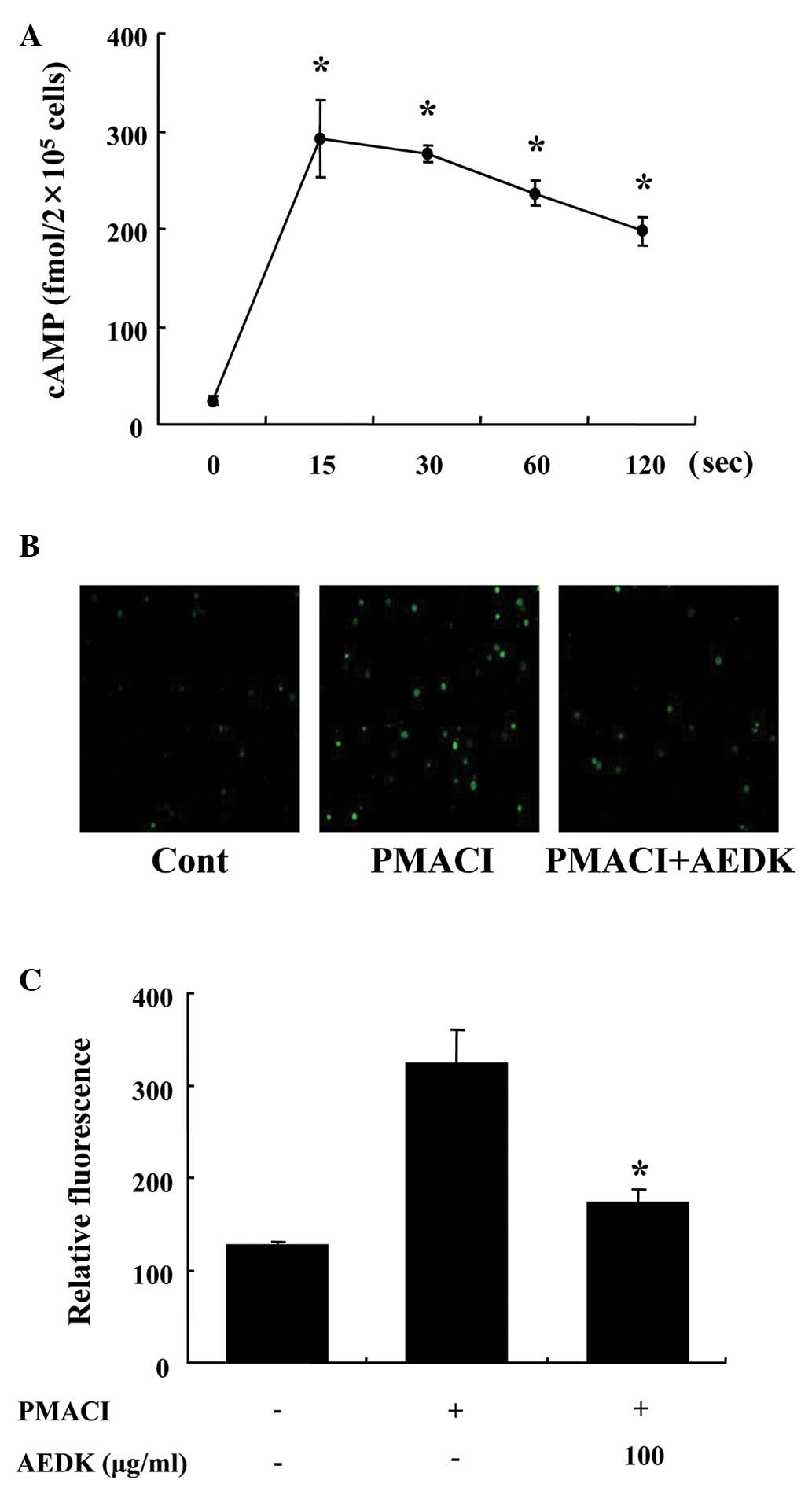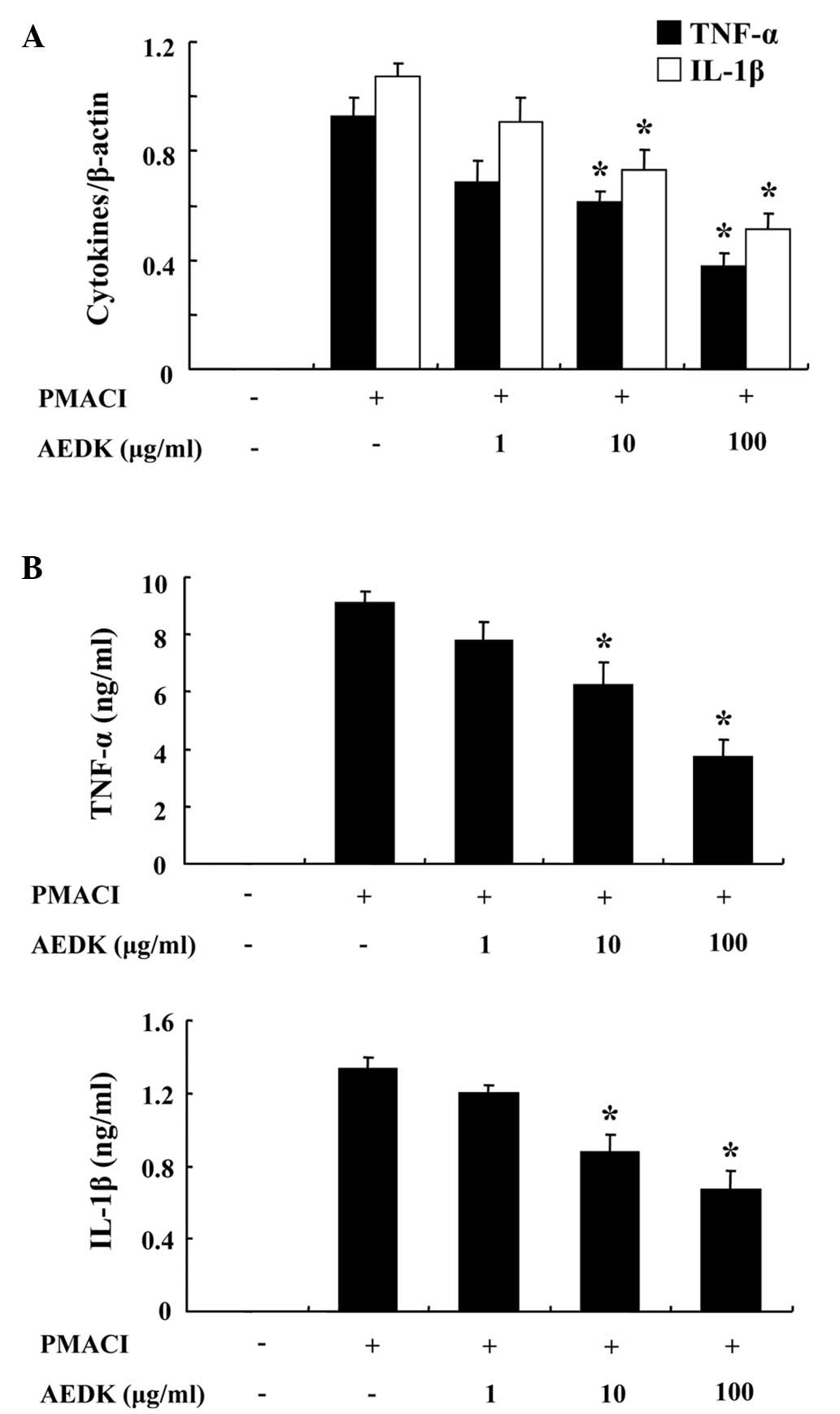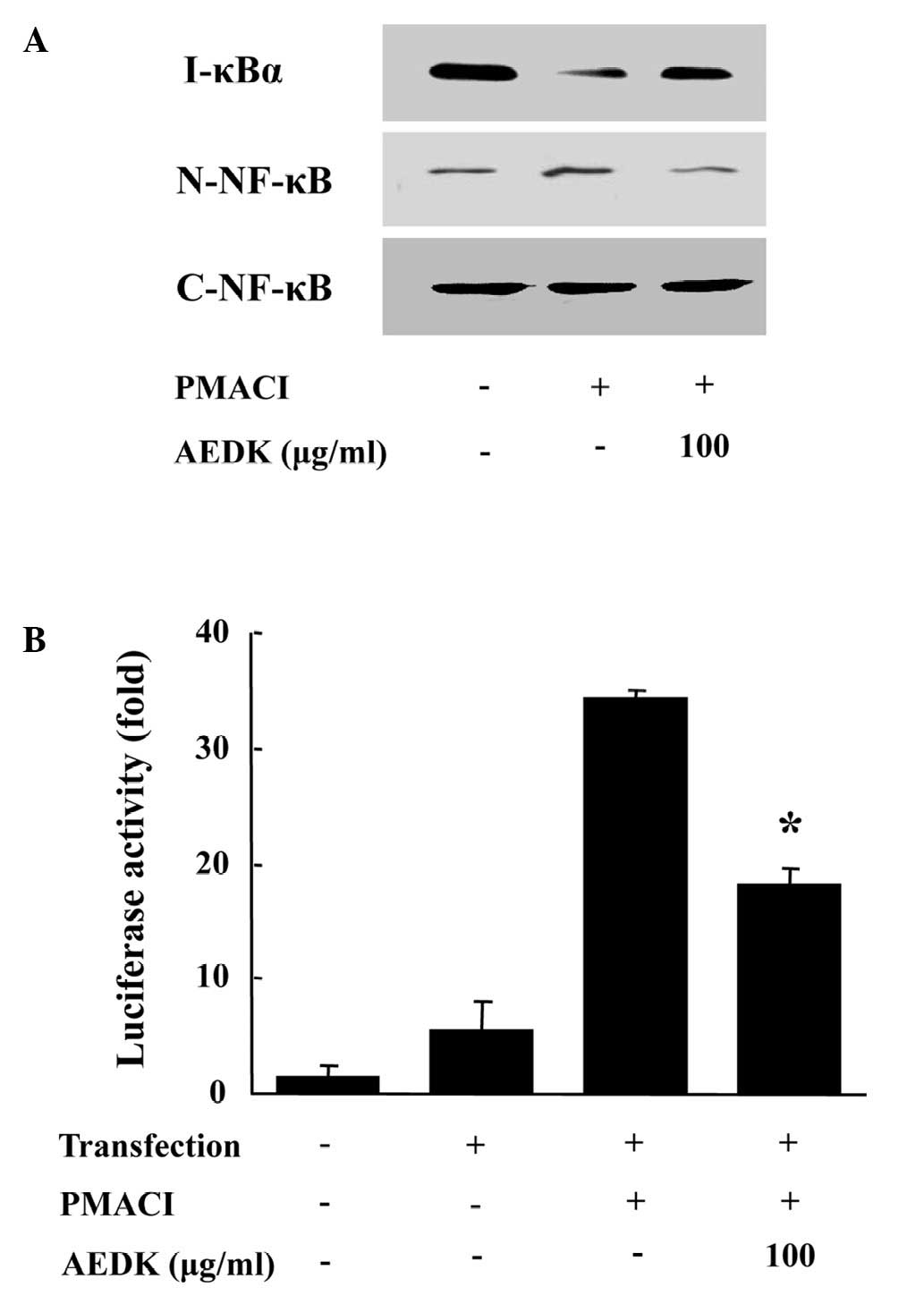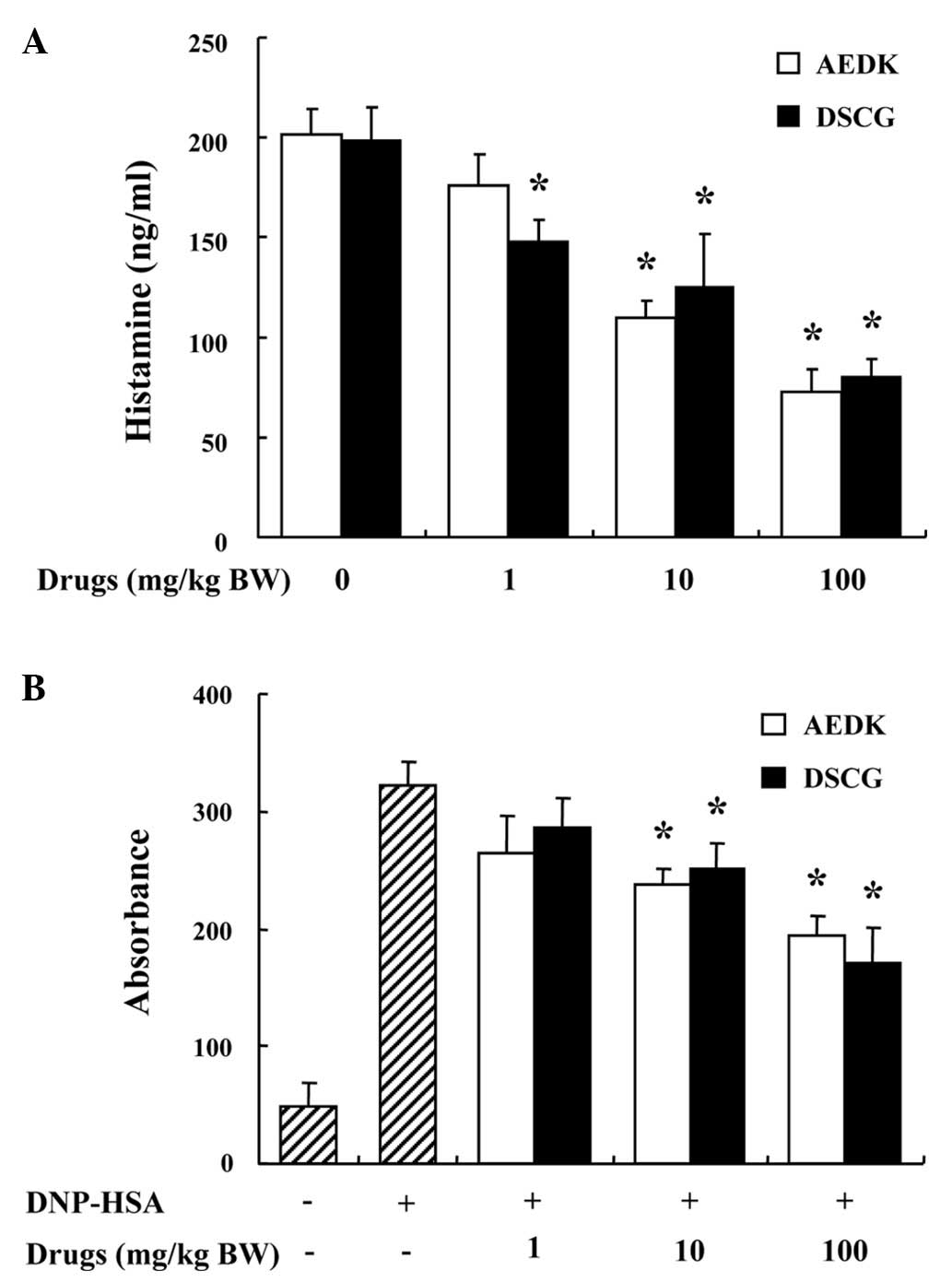Inhibitory effects of Diospyros kaki in a model of allergic inflammation: Role of cAMP, calcium and nuclear factor-κB
- Authors:
- Published online on: August 7, 2013 https://doi.org/10.3892/ijmm.2013.1465
- Pages: 945-951
Abstract
Introduction
Mast cells are broadly distributed throughout mammalian tissues and play an important role as regulators of allergic inflammation in various allergy-related disorders, such as asthma, atopic dermatitis, eczema and sinusitis. Mast cells have been considered not only in association with immediate-type hypersensitivity, but also in delayed hypersensitivity reactions, such as inflammatory response (1,2). Immediate-type hypersensitivity is mediated by histamine in response to the antigen cross-linking of immunoglobulin E (IgE) bound to FcɛRI on mast cells (3). After the activation of mast cells, degranulation is triggered, which results in the release of mediators, such as products of arachidonic acid metabolism, cytokines, proteases and histamine (4,5). In mast cell-mediated inflammatory responses, histamine is one of the most well-characterized and important mediators involved in the acute phase of immediate hypersensitivity (6,7).
Mast cell activation is initiated by the phosphorylation of tyrosine kinase which leads to the activation of protein kinase C, nuclear factor (NF)-κB and the expression of pro-inflammatory cytokines (4,8). Activated mast cells can release histamine and other inflammatory mediators, such as eicosanoids, proteoglycans and a number of pro-inflammatory cytokines, including tumor necrosis factor (TNF)-α, interleukin (IL)-1β, IL-6 and IL-13 (5,9). Although these inflammatory cytokines have beneficial effects on the host defense process, they cause pathological conditions when overexpressed. Therefore, the inhibition of these inflammatory cytokines produced by mast cells is one of the most important targets for the reduction of allergic inflammatory symptoms.
Diospyros kaki (D. kaki) has been cultivated throughout Eastern Asia for hundreds of years. D. kaki contains various biological active compounds, such as amino acids, carotenoids, flavonoids, tannins, catechins and vitamin A (10,11). The leaves of D. kaki are commonly used for tea in Asia. Previous studies have shown that D. kaki has beneficial effects on homeostasis, constipation, hypertension, atherosclerosis and allergic dermatitis and it has been broadly applied in the medicinal area (12–16). D. kaki is also a good source of antioxidants, polyphenols and dietary fiber (17). However, the anti-allergic and anti-inflammatory effects of D. kaki have not yet been elucidated.
In the present study, we investigated the effects of the aqueous extract of D. kaki (AEDK) on allergic inflammation by using in vitro and in vivo mast cell-based models. cAMP levels and the intracellular calcium concentration were investigated to clarify the mechanisms by which AEDK inhibits the release of histamine from mast cells. The effects of AEDK on gene expression and the secretion of pro-inflammatory cytokines and the role of NF-κB in these effects were also investigated. In addition, we examined the effects of AEDK on systemic and local allergic reaction to assess its anti-allergic effects in vivo.
Materials and methods
Reagents and cell culture
Compound 48/80, anti-dinitrophenyl (DNP) IgE, DNP-human serum albumin (HSA), phorbol 12-myristate 13-acetate (PMA), calcium ionophore A23187 and disodium cromoglycate (DSCG) were purchased from Sigma (St. Louis, MO, USA). The human mast cell line (HMC-1) was grown in Iscove’s medium (Life Technologies, Grand Island, NY, USA) supplemented with 10% (v/v) fetal bovine serum at 37°C in 5% CO2. HMC-1 cells of passage 4–8 were used in all the experiments.
Animals
The original stock of male imprinting control region (ICR) mice (6 weeks of age) was purchased from Dae Han Bio Link Co., Ltd (Eumsung-Gun, Korea). The animals were housed 5 per cage in a laminar air flow room maintained under a temperature of 22±2°C and a relative humidity of 55±5% throughout the study. The care and treatment of the mice were in accordance with the guidelines established by the Public Health Service Policy on the Humane Care and Use of Laboratory Animals and were approved by the Animal Care and Use Committee at Kyungpook National University.
Preparation of AEDK, isolation and identification of active compound
D. kaki was supplied from the Korea National Arboretum. A voucher specimen (no. WSP-10-38) was deposited at the herbarium of the College of Pharmacy, Woosuk University, Jeonju, Korea. D. kaki (600 g) was shade dried and powdered. It was then extracted 3 times with purified water (500 ml) at 70°C for 5 h in a water bath and filtered through a Whatman no. 1 filter. The extracts were combined and evaporated. The yield of dried extract from the crude materials was approximately 4.16% (w/w). The dried extract of AEDK was dissolved in saline or Tyrode buffer and was filtered using a 0.45 μm syringe filter. To isolate the active components responsible for the anti-allergic and anti-inflammatory effects of AEDK, the resultant water extract (70 g) was successively partitioned as chloroform, ethyl acetate, n-butanol and water soluble fractions. The ethyl acetate soluble fraction exhibited the highest anti-allergic activity. The ethyl acetate soluble fraction was chromatographed on a Sephadex LH-20 column (MeOH) (GE Healthcare Bio-Sciences, Uppsala, Sweden) to yield 5 fractions (E1–E5). E2 was subjected to chromatography on a Sephadex LH-20 gel column (MeOH) to yield compound 1 (25 mg). The molecular formulae of compound 1 were characterized by nuclear magnetic resonance (NMR). By comparing the NMR data and literature values (18,19), compound 1 was identified as a catechin.
Histamine and β-hexosaminidase levels
The degranulation of mast cells was monitored by measuring the release of histamine and β-hexosaminidase. The histamine content in serum and HMC-1 cells was measured using the o-phthaldialdehyde spectrofluorometric procedure as previously described (20). HMC-1 cells (1×106 cells/ml) were pre-incubated with AEDK for 30 min, and then incubated for 30 min with PMA (20 nM) and calcium ionophore A23187 (PMACI) (1 μM) as previously described (21). The release of β-hexosaminidase was measured as previously described (22). In brief, the HMC-1 cells were treated with AEDK at 37°C for 30 min. The cells were sensitized with PMACI for 30 min and placed on ice for 10 min to terminate the reaction.
cAMP and intracellular calcium levels
The cAMP level was measured as previously described (4). The intracellular calcium concentration was measured with the use of the fluorescence indicator Fluo-3/AM (Molecular Probes, Eugene, OR, USA). The HMC-1 cells were pre-incubated with Fluo-3/AM for 30 min at 37°C. After washing the dye from the cell surface, the cells were treated with AEDK for 5 min prior to the addition of PMACI. They were excited at 488 nm, the emission was filtered with 515 nm by a flow cytometer (BD Biosciences Pharmingen, San Diego, CA, USA) and visualized under a fluorescence microscope (Olympus BX51; Olympus, Center Valley, PA, USA).
Real-time PCR and enzyme-linked immunosorbent assay (ELISA)
Total cellular RNA was isolated from the cells (1×106 cells/well in a 24-well plate) following stimulation with PMACI with or without AEDK for 4 h. Real-time polymerase chain reaction (PCR) was used to analyze the mRNA expression of TNF-α, IL-1β and β-actin (internal control) as previously described (23). The band intensity was normalized to that of β-actin in the same sample. The secretion of TNF-α and IL-1β was measured by ELISA as previously described (4). The HMC-1 cells were cultured in medium and resuspended in Tyrode buffer A. The cells were sensitized with PMACI for 8 h in the absence or presence of AEDK.
Western blot analysis and luciferase activity assay
The samples were electrophoresed using 12% sodium dodecyl sulfate-polyacrylamide gel electrophoresis, as previously described (24) and then transferred onto a nitrocellulose membrane. Nuclear and cytosolic p65 NF-κB and IκBα were assayed using anti-NF-κB (p65) and anti-IκBα antibody (Santa Cruz Biotechnology, Santa Cruz, CA, USA). Luciferase activity was measured as previously described (21). The HMC-1 cells were seeded at 2×106 in a 6-well plate 1 day prior to transient transfection. After the transfected cells were incubated for 18 h, they were stimulated with PMACI at 37°C for 2 h. The cells were pre-treated with AEDK for 30 min prior to stimulation with PMACI. Luciferase activity was determined using a luminometer.
Systemic anaphylaxis
Mice were administered an intraperitoneal injection [8 mg/kg of body weight (BW)] of the mast cell degranulator, compound 48/80. AEDK was dissolved in saline and administered intraperitoneally (1–100 mg/kg BW) 1 h prior to the injection of compound 48/80 (n=10/group). Mortality was monitored for 1 h after the induction of anaphylactic shock. After the mortality test, blood was obtained from the heart of each mouse to measure the serum histamine content.
Passive cutaneous anaphylaxis (PCA)
An IgE-dependent cutaneous reaction was carried out as previously described (23). The mice were injected intradermally with 0.5 μg of anti-DNP IgE. After 48 h, each mouse (n=10/group) received an injection of 1 μg of DNP-HSA containing 4% Evans blue (1:4) via the tail vein. Thirty minutes after the challenge, the mice were sacrificed and the dorsal skin (diameter, 1 cm) was removed in order to measure the pigmented area. The amount of dye was then determined colorimetrically.
Statistical analysis
Statistical analyses were performed using SAS statistical software (SAS Institute, Cary, NC). The effects of treatment were analyzed using an analysis of variance, followed by Duncan’s multiple range tests. A P-value <0.05 was considered to indicate a statistically significant difference.
Results
Effects of AEDK on the release of histamine and β-hexosaminidase
We determined the effects of AEDK on the degranulation of mast cells. The release of histamine and β-hexosaminidase from activated mast cells is a hallmark of degranulation. HMC-1 cells released a high level of histamine when stimulated with PMACI (Fig. 1A). When pre-treated with AEDK (1–100 μg/ml) for 30 min, histamine levels were dose-dependently inhibited in the PMACI-stimulated HMC-1 cells. To confirm the inhibitory effects of AEDK on the degranulation of mast cells, we investigated the effects of AEDK on the release of β-hexodaminidase (Fig. 1B). The results revealed that 10 to 100 μg/ml AEDK significantly decreased the PMACI-stimulated release of β-hexodaminidase from HMC-1 cells. The concentration and duration of AEDK treatment used in these experiments had no significant effect on the cell viability of HMC-1 cells (data not shown).
Effects of AEDK on cAMP and intracellular calcium levels
To investigate the mechanisms responsible for the reduction in the levels of histamine following treatment with AEDK, we assayed the cAMP and intracellular calcium levels. When the HMC-1 cells were incubated with AEDK (100 μg/ml), the cAMP content increased within 15 sec and remained at relatively high levels for 120 sec (Fig. 2A). Calcium movements across the membranes of mast cells are critical to histamine release (25). To further investigate the mechanisms responsible for the reduction of the release of histamine by AEDK, we assayed the intracellular calcium levels. When the HMC-1 cells were stimulated with PMACI, the intracellular calcium level was significantly elevated (Fig. 2B). However, the pre-incubation of HMC-1 cells with AEDK (100 μg/ml) decreased the intracellular calcium level induced by PMACI. The level of intracellular calcium was also depicted by the relative fluorescence intensity (Fig. 2C).
Effects of AEDK on the expression and secretion of pro-inflammatory cytokines
We investigated the inhibitory effects of AEDK on the expression of pro-inflammatory cytokines, such as TNF-α and IL-1β. Previously, we reported that the gene expression of TNF-α and IL-1β peaked 4 h after treatment with PMACI (26). Consequently, the HMC-1 cells were stimulated with PMACI for 4 h following pre-treatment with AEDK for 30 min. Fig. 3A illustrates that the expression of pro-inflammatory cytokines was inhibited by AEDK. To confirm the correlation of mRNA expression with protein production, we evaluated the secretion of TNF-α and IL-1β with ELISA. When the HMC-1 cells were stimulated with PMACI for 8 h, the secretion of cytokines was markedly induced. The secretion of TNF-α and IL-1β was significantly inhibited by AEDK (10 and 100 μg/ml) in the PMACI-stimulated HMC-1 cells (Fig. 3B).
Effects of AEDK on the activation of NF-κB
To investigate the intracellular mechanisms responsible for the inhibitory effects of AEDK on the expression of pro-inflammatory cytokines, we examined the effects of AEDK on the activation of the transcription factor, NF-κB. NF-κB is an important transcriptional regulator of inflammatory cytokines and plays a crucial role in immune and inflammatory responses (4). The stimulation of HMC-1 cells with PMACI induced the nuclear translocation of p65 NF-κB and the degradation of IκBα. AEDK inhibited the PMACI-induced nuclear translocation of NF-κB and the degradation of IκBα (Fig. 4A). To confirm the inhibitory effects of AEDK on NF-κB activation, we used an NF-κB-dependent gene reporter assay. The HMC-1 cells were transiently transfected with a NF-κB-luciferase reporter construct or an empty vector. Exposure of the cells to PMACI increased the luciferase activity in the cells transfected with the NF-κB-luciferase reporter construct (Fig. 4B). AEDK (100 μg/ml) significantly reduced the PMACI-induced luciferase activity.
Effects of AEDK on systemic and local allergic reactions
To determine the effects of AEDK on allergic reaction, an in vivo model of systemic anaphylaxis was used. Compound 48/80 (8 mg/kg, BW) was used as a model of induction for a systemic fatal allergic reaction. Groups of mice (n=10/group) were intraperitoneally injected with 200 μl of saline or drugs at various doses, 1 h before the intraperitoneal injection of compound 48/80. After the intraperitoneal injection of compound 48/80, the mice were monitored for 1 h, after which the mortality rate was determined as the number of dead mice ×100/total number of experimental mice. All mice underwent fatal shock after the injection of compound 48/80. We compared the anti-anaphylactic effects of AEDK with DSCG, a known anti-allergic drug. When AEDK and DSCG were intraperitoneally administered, at doses ranging from 1 to 100 mg/kg (BW) for 1 h, the mortality rate was dose-dependently reduced (Table I). The effect of AEDK on the compound 48/80-induced release of histamine in serum was also investigated. AEDK and DSCG were administered 1 h prior to the injection of compound 48/80. The injection of compound 48/80 induced a marked increase in the release of histamine in serum, which was inhibited by treatment with AEDK in a dose-dependent manner (Fig. 5A).
Another way to examine the anaphylactic reaction is to induce PCA. A local extravasation was induced by the local injection of IgE followed by an antigenic challenge. AEDK and DSCG were intraperitoneally administered at 1 to 100 mg/kg (BW) 1 h prior to the antigen challenge. AEDK dose-dependently reduced the IgE-mediated PCA reaction (Fig. 5B). The inhibitory effects of AEDK on systemic and local anaphylaxis were similar to those of DSCG.
Discussion
Immediated-type hypersensitivity is a life-threatening syndrome induced by the sudden systemic release of inflammatory mediators such as histamine and cytokines (27). A number of studies have established that the stimulation of mast cells initiates the activation of signal transduction pathways, which leads to degranulation. In this study, we demonstrate that AEDK inhibits systemic allergic reaction and the release of histamine in serum, which is an index of mast cell degranulation. In addition, the administration of AEDK to mice protected them from IgE-mediated PCA, one of the most important in vivo modes of acute local anaphylaxis. In both systemic and local anaphylaxis, the inhibitory effects of AEDK were comparable to those of DSCG, a clinically used medication for treating asthma and allergies. These findings suggest that AEDK may prove useful in the treatment of allergic diseases.
cAMP and intracellular calcium pathways are critical to the release of allergic inflammatory mediators, such as histamine from mast cells (4). Calcium movements across the membranes of mast cells represent a major target for anti-allergic drugs, as these are essential events linking stimulation to secretion (28). The transduction pathways modulating cAMP and intracellular calcium are modified by the ADP-ribosylation of G-protein (29). The release of histamine is known to be reduced by an increase in the intracellular cAMP level due to the activation of adenylate cyclase or the inhibition of cAMP phosphodiesterase (30). cAMP-elevating drugs, such as AEDK, inhibit the release of calcium from intracellular calcium stores, indicating the regulatory role of cAMP in the release of histamine. According to these results, we suggest that the increase in cAMP and the decrease in calcium levels may be involved in the inhibitory effects of AEDK on the release of histamine.
TNF-α and IL-1β play an important role in triggering and sustaining allergic inflammation in mast cells (2,31). Mast cells are a principal source of TNF-α and IL-1β in the human dermis. TNF-α and IL-1β promote inflammation, leukocyte infiltration, the chemotaxis of neutrophils and stimulate T cells, thereby contributing to chronic inflammation. Therefore, the reduction in the levels of pro-inflammatory cytokines from mast cells is one of the key indicators of reduced allergic inflammatory symptoms. The expression of TNF-α and IL-1β is regulated by the activation of the transcription factor, NF-κB (32). NF-κB regulates the expression of multiple inflammatory- and immune-related genes and plays a critical role in chronic inflammatory diseases. In PMACI-stimulated mast cells, AEDK inhibited the expression of TNF-α and IL-1β and decreased the activation of NF-κB. These data demonstrated that AEDK attenuates the activation of NF-κB and the expression of downstream cytokines, such as TNF-α and IL-1β.
To isolate the active components responsible for the anti-allergic and anti-inflammatory effects of AEDK, we partitioned AEDK as shown in Materials and methods and defined catechin as an active component of AEDK. The anti-allergic and anti-inflammatory properties of epigallocatechin-3-gallate (EGCG) are well known (33). Due to the structural similarity of EGCG and catechin, we hypothesized that catechin may be one of the compounds responsible for the anti-allergic and anti-inflammatory effects of AEDK. In conclusion, the present study demonstrates that AEDK significantly reduces mast cell-mediated allergic inflammation in in vitro and in vivo models. We suggest that AEDK reduces the release of histamine by modulating cAMP and intracellular calcium levels. AEDK inhibits the expression and secretion of inflammatory cytokines by suppressing NF-κB. We provide evidence that AEDK may contribute to the prevention or treatment of mast cell-mediated allergic inflammatory diseases.
Acknowledgements
This study was supported by NRF funded by the Ministry of Science, ICT & Future Planning (2012M3A9B6055416).
References
|
Caughey GH: Mast cell proteases as protective and inflammatory mediators. Adv Exp Med Biol. 716:212–234. 2011. View Article : Google Scholar : PubMed/NCBI | |
|
Galli SJ, Tsai M and Piliponsky AM: The development of allergic inflammation. Nature. 454:445–454. 2008. View Article : Google Scholar : PubMed/NCBI | |
|
Galli SJ, Kalesnikoff J, Grimbaldeston MA, Piliponsky AM, Williams CM and Tsai M: Mast cells as ‘tunable’ effector and immunoregulatory cells: recent advances. Annu Rev Immunol. 23:749–786. 2005. | |
|
Kim SH, Jun CD, Suk K, et al: Gallic acid inhibits histamine release and pro-inflammatory cytokine production in mast cells. Toxicol Sci. 91:123–131. 2006. View Article : Google Scholar : PubMed/NCBI | |
|
Amin K: The role of mast cells in allergic inflammation. Respir Med. 106:9–14. 2012. View Article : Google Scholar : PubMed/NCBI | |
|
Lee DH, Kim SH, Eun JS and Shin TY: Mosla dianthera inhibits mast cell-mediated allergic reactions through the inhibition of histamine release and inflammatory cytokine production. Toxicol Appl Pharmacol. 216:479–484. 2006. View Article : Google Scholar | |
|
Tagen M, Elorza A, Kempuraj D, et al: Mitochondrial uncoupling protein 2 inhibits mast cell activation and reduces histamine content. J Immunol. 183:6313–6319. 2009. View Article : Google Scholar : PubMed/NCBI | |
|
Gwack Y, Feske S, Srikanth S, Hogan PG and Rao A: Signalling to transcription: store-operated Ca2+ entry and NFAT activation in lymphocytes. Cell Calcium. 42:145–156. 2007. View Article : Google Scholar : PubMed/NCBI | |
|
Sismanopoulos N, Delivanis DA, Alysandratos KD, et al: Mast cells in allergic and inflammatory diseases. Curr Pharm Des. 18:2261–2277. 2012. View Article : Google Scholar : PubMed/NCBI | |
|
Mallavadhani UV, Panda AK and Rao YR: Pharmacology and chemotaxonomy of Diospyros. Phytochemistry. 49:901–951. 1998.PubMed/NCBI | |
|
Duan J, Zheng Y, Dong Q and Fang J: Structural analysis of a pectic polysaccharide from the leaves of Diospyros kaki. Phytochemistry. 65:609–615. 2004. View Article : Google Scholar : PubMed/NCBI | |
|
Matsumoto N, Okushio K and Hara Y: Effect of black tea polyphenols on plasma lipids in cholesterol-fed rats. J Nutr Sci Vitaminol (Tokyo). 44:337–342. 1998. View Article : Google Scholar : PubMed/NCBI | |
|
Kotani M, Matsumoto M, Fujita A, et al: Persimmon leaf extract and astragalin inhibit development of dermatitis and IgE elevation in NC/Nga mice. J Allergy Clin Immunol. 106:159–166. 2000. View Article : Google Scholar : PubMed/NCBI | |
|
Kameda K, Takaku T, Okuda H, et al: Inhibitory effects of various flavonoids isolated from leaves of persimmon on angiotensin-converting enzyme activity. J Nat Prod. 50:680–683. 1987. View Article : Google Scholar : PubMed/NCBI | |
|
Funayama S and Hikino H: Hypotensive principles of Diospyros kaki leaves. Chem Pharm Bull (Tokyo). 27:2865–2868. 1979. View Article : Google Scholar | |
|
Sun L, Zhang J, Lu X, Zhang L and Zhang Y: Evaluation to the antioxidant activity of total flavonoids extract from persimmon (Diospyros kaki L.) leaves. Food Chem Toxicol. 49:2689–2696. 2011. View Article : Google Scholar : PubMed/NCBI | |
|
Steinmetz KA and Potter JD: Vegetables, fruit, and cancer prevention: a review. J Am Diet Assoc. 96:1027–1039. 1996. View Article : Google Scholar : PubMed/NCBI | |
|
Rattmann YD, Cipriani TR, Sassaki GL, et al: Nitric oxide-dependent vasorelaxation induced by extractive solutions and fractions of Maytenus ilicifolia Mart ex Reissek (Celastraceae) leaves. J Ethnopharmacol. 104:328–335. 2006. View Article : Google Scholar : PubMed/NCBI | |
|
Ali K, Maltese F, Toepfer R, Choi YH and Verpoorte R: Metabolic characterization of Palatinate German white wines according to sensory attributes, varieties, and vintages using NMR spectroscopy and multivariate data analyses. J Biomol NMR. 49:255–266. 2011. View Article : Google Scholar | |
|
Kim SH, Lee S, Kim IK, et al: Suppression of mast cell-mediated allergic reaction by Amomum xanthioides. Food Chem Toxicol. 45:2138–2144. 2007. View Article : Google Scholar : PubMed/NCBI | |
|
Kim HH, Yoo JS, Lee HS, Kwon TK, Shin TY and Kim SH: Elsholtzia ciliata inhibits mast cell-mediated allergic inflammation: role of calcium, p38 mitogen-activated protein kinase and nuclear factor-{kappa}B. Exp Biol Med (Maywood). 236:1070–1077. 2011. View Article : Google Scholar : PubMed/NCBI | |
|
Itoh T, Tsukane M, Koike M, et al: Inhibitory effects of whisky congeners on IgE-mediated degranulation in rat basophilic leukemia RBL-2H3 cells and passive cutaneous anaphylaxis reaction in mice. J Agric Food Chem. 58:7149–7157. 2010. View Article : Google Scholar : PubMed/NCBI | |
|
Bae Y, Lee S and Kim SH: Chrysin suppresses mast cell-mediated allergic inflammation: involvement of calcium, caspase-1 and nuclear factor-kappaB. Toxicol Appl Pharmacol. 254:56–64. 2011. View Article : Google Scholar : PubMed/NCBI | |
|
Lee S, Yun HS and Kim SH: The comparative effects of mesoporous silica nanoparticles and colloidal silica on inflammation and apoptosis. Biomaterials. 32:9434–9443. 2011. View Article : Google Scholar : PubMed/NCBI | |
|
Eisenhut M and Wallace H: Ion channels in inflammation. Pflugers Arch. 461:401–421. 2011. View Article : Google Scholar : PubMed/NCBI | |
|
Park HH, Lee S, Oh JM, et al: Anti-inflammatory activity of fisetin in human mast cells (HMC-1). Pharmacol Res. 55:31–37. 2007. View Article : Google Scholar : PubMed/NCBI | |
|
Boden SR and Wesley Burks A: Anaphylaxis: a history with emphasis on food allergy. Immunol Rev. 242:247–257. 2011. View Article : Google Scholar : PubMed/NCBI | |
|
Beaven MA, Rogers J, Moore JP, Hesketh TR, Smith GA and Metcalfe JC: The mechanism of the calcium signal and correlation with histamine release in 2H3 cells. J Biol Chem. 259:7129–7136. 1984.PubMed/NCBI | |
|
Alfonso A, Cabado AG, Vieytes MR and Botana LM: Functional compartments in rat mast cells for cAMP and calcium on histamine release. Cell Signal. 12:343–350. 2000. View Article : Google Scholar : PubMed/NCBI | |
|
Makino H, Saijo T, Ashida Y, Kuriki H and Maki Y: Mechanism of action of an antiallergic agent, amlexanox (AA-673), in inhibiting histamine release from mast cells. Acceleration of cAMP generation and inhibition of phosphodiesterase. Int Arch Allergy Appl Immunol. 82:66–71. 1987. View Article : Google Scholar | |
|
Walsh LJ, Trinchieri G, Waldorf HA, Whitaker D and Murphy GF: Human dermal mast cells contain and release tumor necrosis factor alpha, which induces endothelial leukocyte adhesion molecule 1. Proc Natl Acad Sci USA. 88:4220–4224. 1991. View Article : Google Scholar | |
|
Karin M: NF-kappaB as a critical link between inflammation and cancer. Cold Spring Harb Perspect Biol. 1:a0001412009. View Article : Google Scholar : PubMed/NCBI | |
|
Bani D, Giannini L, Ciampa A, et al: Epigallocatechin-3-gallate reduces allergen-induced asthma-like reaction in sensitized guinea pigs. J Pharmacol Exp Ther. 317:1002–1011. 2006. View Article : Google Scholar : PubMed/NCBI |



